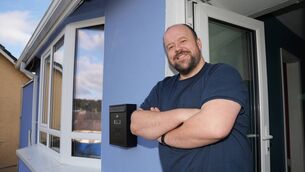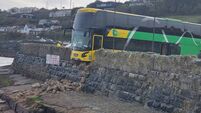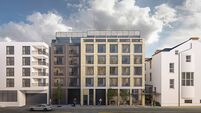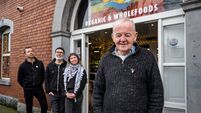Ballycotton - black is the colour

From the long strand at Garryvoe Beach, a prominent island captures the gaze. The truncated triangle of Ballycotton Island, with its striking lighthouse has long been a focal point for locals and visitors and a favourite subject for budding and blossomed photographers.
A tour of the island’s lighthouse was set up in the last few years which has opened up this stunning island to the public. However, Ballycotton nearly didn’t get a lighthouse at all as the nearby Capel Island was the designated site for construction to save lives of imperilled sailors and passengers.
Construction at Capel got so far as establishing the base of the tower. However, the sinking of the Sirius in 1847 concentrated minds and Ballycotton was instead chosen as the lighthouse site.
The Sirius was sailing from Glasgow to Cork via Dublin, but foundered on a reef on January 16, 1847, near Ballycotton Island. The disaster claimed the lives of 20 passengers and crew but around 70 people lived to tell the tale.
Public pressure brought about a review and a notice was placed in the Cork Examiner on December 24, 1847 to the effect that:
“The Cork Harbour Commissioners having received intimation that it is intended to construct a lighthouse on Cable Island and as some nautical men are of opinion that Ballycotton Island would be a much more suitable position, the Commissioners request the attendance of Shipmasters and other competent persons at a meeting to be held in the Ballast Office on 12 January, 1848 to take the subject into consideration in order that they may be enabled to recommend the most eligible site for that purpose”.
The notice is signed, “By Order, Joseph F Spearing, Secretary.”
In a satirical skit on January 17, 1848, a Cork Examiner writer wrote “Which of us shall have the lighthouse?” “I must have it says Ballycotton Island”.
“No, it is I must get it,” rejoins Cable Island. “Well if I can’t get it, you shan’t have it and then we will both be in the dark.”
Ultimately the chips fell for Ballycotton. “Give me Cable Island, says Captain Attridge.” We three are for Ballycotton,” say Mr Ffrench, Gallway and Mr Boland in most harmonious chorus.”
Before the clincher — “I was for Cable Island but my mind is changed and I am now for Ballycotton, says Lieutenant Waters
The lighthouse was constructed by 1851. The lens for the powerful beam was the only one of its type in Ireland. The catadioptric apparatus was supplied from London with a French design.
The absolute necessity of having the lighthouse constructed was illustrated in a a commentary in The Kerryman a few years afterwards:
“Among the vessels lost within the last 20 years are the Sovereign from Africa, value £20,000, 28 lives lost; the Nice bound to Africa, value £14,000, 16 lives lost; City of Bristol steamer, stranded, value £80,000, crew and cargo saved; Clemenston Barque, from South America, value £28,000 two lives lost; Sirius Steamer value £50,000, cargo and 20 lives lost.”
Of the loss of the Sovereign, the Cork Examiner reported that “Denis Flynn with his two brothers and four other fishermen put off in Flynn’s yawl and after three hours reached the wreck. They proceeded to rescue eight men who had been clinging to the mizen.”
It is the rival nature with Capel Island that marks Ballycotton as one of the most distinctive in the world. In contrast to most other white lighthouses in Ireland it was painted black in 1902 to distinguish it from the beacon at Capel. Slyne Head in Co Galway is also black.
The tour to the island leads visitors up from the pier to the lighthouse compound.
Former lighthouse keeper, Eddie Fitzgerald, who worked on the Ballycotton lighthouse in the late 1960s is one of the current guides. When the tours began in 2014 he told this paper:
“A lot of our work was routine — maintaining the light, and fog signal, doing the weather reports, and acting as unofficial coast guard. We had our own herd of goats as well.”
Originally, the keepers lived on the island before being relocated to Ballycotton itself. The tradition of lighthousekeeping which began in 1851 was ended in 1992 when the light was automated and the lighthousekeepers left the island for good. n How to get there; ballycottonseaadventures.com Other: www.irishlights













